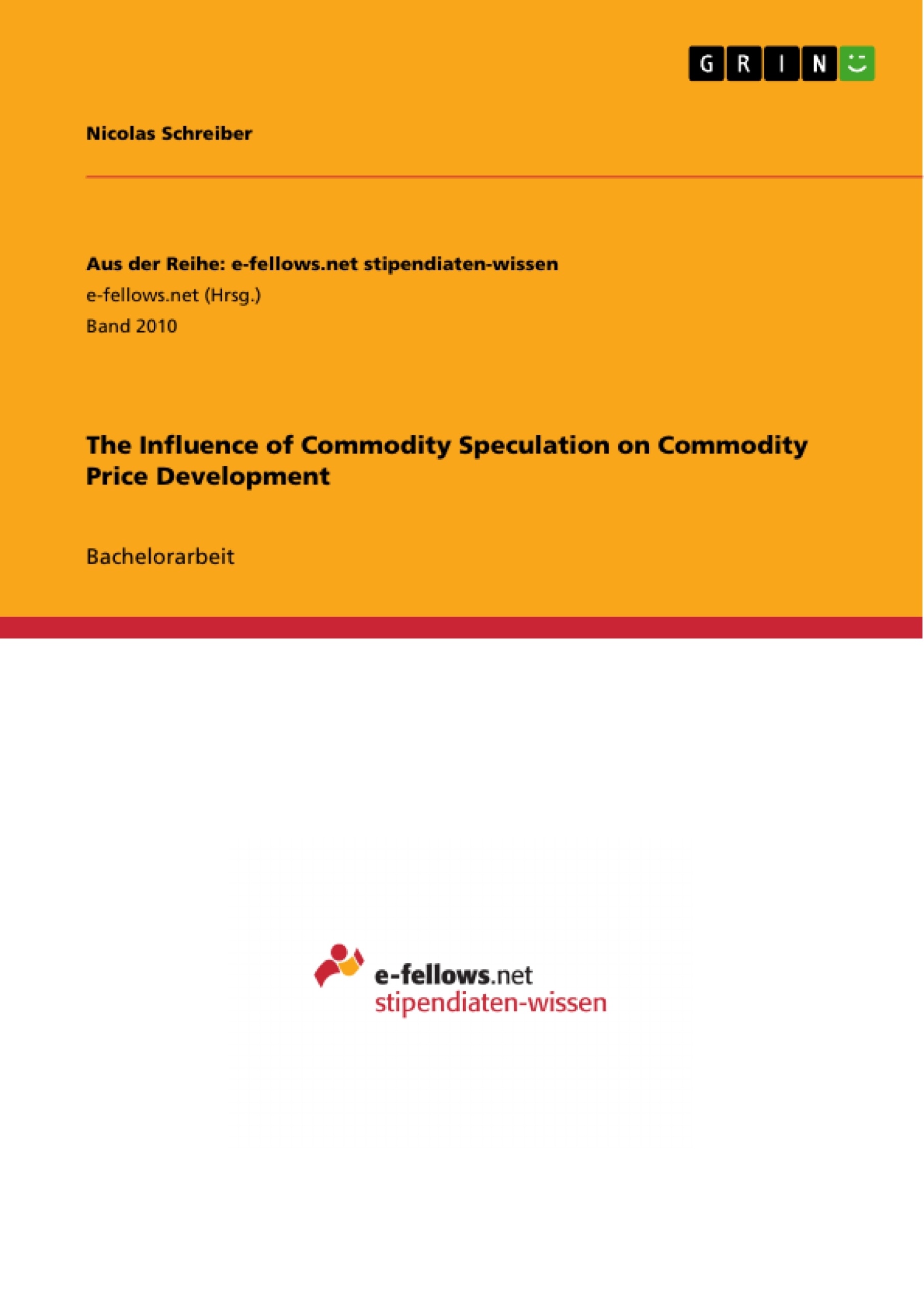Commodity prices have been rising significantly since the early 2000s with price growth reaching its fastest pace between 2006 and 2008. While nearly all commodities were hit by the aforementioned price spikes, price spikes where particularly pronounced for mineral commodities.
For the most part of recent research two different approaches are applied to measure the impact of speculation on price development. The first one examines if there is any change in commodity price development due to the aforementioned increased financialization of commodity markets, whereas the second one compares the behavior of commodity prices with and without an existing futures market.
This thesis combines both approaches and tests the hypotheses that either the first-time introduction of derivatives or the introductions of regulatory governmental acts that facilitate speculative index investment in commodities have significant effects on commodity price development by the example of copper traded on US-based exchanges. For this purpose, relevant copper price characteristics will be analyzed before and after possibly speculation-conducive events (i.e. the introduction of copper futures trading and two selected acts) for the period from 1971 to 2010. Furthermore, following Tang and Xiong (2012), this thesis examines if the introduction of governmental acts of the aforementioned type induces an increased market integration of non-energy commodity markets. This is of particular interest as market integration can at times induce increased volatility spillovers between the respective markets (Tang & Xiong, 2012).
The first part of this work gives a short overview of the technical background necessary to understand the relationship between commodity prices and speculation. The second part provides a general review of related literature and research on the relationship between commodity prices and speculation. The third part focuses on the methodology of the empirical analysis. The fourth part of this work presents the results and is followed by the conclusion in part five.
Inhaltsverzeichnis
- LIST OF FIGURES.
- LIST OF TABLES
- LIST OF ABBREVIATIONS.
- LIST OF SYMBOLS
- INTRODUCTION.
- THEORETICAL BACKGROUND
- REGULATION OF COMMODITY MARKETS
- PECULIARITIES OF COMMODITY TRADING.
- Futures Trading for Hedging Purposes...
- Futures Trading for Speculative Purposes.
- LITERATURE REVIEW
- EMPIRICAL ANALYSIS – HYPOTHESES AND METHODOLOGY
- HYPOTHESES
- METHODOLOGY.
- Definition of Fundamental Elements.
- Analysis Methodology..
- EMPIRICAL ANALYSIS - RESULTS
- EFFECTS OF THE FIRST-TIME INTRODUCTION OF A DERIVATIVE
- Volatility Analysis......
- Delta Analysis
- Correlation Analysis...
- Regression Analysis..
- EFFECTS OF REGULATORY ACTS ON MARKET INTEGRATION AND COPPER PRICES
- Commodity Futures Modernization Act
- Volatility Analysis.
- Delta Analysis.......
- Correlation Analysis.
- Regression Analysis..
- Increase in Speculative Position Limits..
- Volatility Analysis.
- Delta Analysis.....
- Correlation Analysis.
- Regression Analysis..
- Commodity Futures Modernization Act
- EFFECTS OF THE FIRST-TIME INTRODUCTION OF A DERIVATIVE
Zielsetzung und Themenschwerpunkte
Diese Bachelorarbeit untersucht den Einfluss von Rohstoff-Spekulation auf die Preisentwicklung von Rohstoffen. Die Arbeit analysiert die Auswirkungen von Spekulation auf die Volatilität, die Korrelation und die Preisentwicklung von Rohstoffen. Besondere Aufmerksamkeit wird dabei auf die Auswirkungen von Regulierungsmaßnahmen gelegt, die darauf abzielen, den Einfluss der Spekulation auf die Rohstoffmärkte zu begrenzen.
- Einfluss von Rohstoff-Spekulation auf die Rohstoffpreisentwicklung
- Analyse der Auswirkungen von Spekulation auf die Volatilität, die Korrelation und die Preisentwicklung von Rohstoffen
- Auswirkungen von Regulierungsmaßnahmen auf die Rohstoffmärkte
- Bedeutung der Spekulation für die Funktionsweise der Rohstoffmärkte
- Risiken und Chancen der Rohstoff-Spekulation
Zusammenfassung der Kapitel
- Einführung: Diese Einleitung stellt das Thema der Arbeit vor und erläutert die Relevanz des Themas für die Wirtschaft und Gesellschaft.
- Theoretischer Hintergrund: Dieses Kapitel bietet einen Überblick über die theoretischen Grundlagen der Rohstoffmärkte und die Rolle der Spekulation. Es beschreibt die verschiedenen Arten von Rohstoff-Derivaten und die Funktionsweise der Handelsplätze.
- Regulierung der Rohstoffmärkte: In diesem Kapitel werden die wichtigsten Regulierungsmaßnahmen auf den Rohstoffmärkten vorgestellt. Die Arbeit untersucht, wie diese Maßnahmen den Einfluss der Spekulation auf die Märkte beeinflussen.
- Besonderheiten des Rohstoffhandels: Dieses Kapitel befasst sich mit den besonderen Eigenschaften des Rohstoffhandels, insbesondere dem Futures-Handel. Es werden die Unterschiede zwischen dem Hedging und dem Spekulieren im Rohstoffhandel erläutert.
- Literaturüberblick: Dieses Kapitel bietet einen Überblick über die bestehende Literatur zum Thema Rohstoff-Spekulation. Es werden die wichtigsten Studien und Theorien zum Einfluss der Spekulation auf die Preisentwicklung vorgestellt.
- Empirische Analyse – Hypothesen und Methodik: Dieses Kapitel definiert die Hypothesen der Arbeit und erläutert die Methodik der empirischen Analyse. Es wird die Vorgehensweise zur Datenerhebung und -analyse beschrieben.
- Empirische Analyse – Ergebnisse: Dieses Kapitel präsentiert die Ergebnisse der empirischen Analyse. Die Arbeit analysiert die Auswirkungen von Spekulation auf die Volatilität, die Korrelation und die Preisentwicklung von Rohstoffen. Es werden auch die Auswirkungen von Regulierungsmaßnahmen auf die Märkte untersucht.
Schlüsselwörter
Diese Bachelorarbeit beschäftigt sich mit den Schlüsselbegriffen Rohstoff-Spekulation, Rohstoffpreisentwicklung, Futures-Handel, Hedging, Regulierung, Volatilität, Korrelation, Regression, Commodity Futures Modernization Act, Position Limits, empirische Analyse, quantitative Analyse.
- Citar trabajo
- Nicolas Schreiber (Autor), 2014, The Influence of Commodity Speculation on Commodity Price Development, Múnich, GRIN Verlag, https://www.grin.com/document/336450



